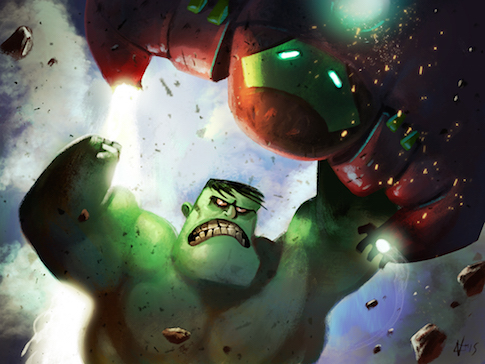Plot points of Avengers: Age of Ultron are discussed throughout.
I realized the other day that what most annoys me about the films that make up the Marvel Cinematic Universe—the Avengers series and the stand-alone movies about its members—is the complete and utter lack of stakes.
Oh, sure, the whole world is in jeopardy yet again, just as it was in Avengers and Thor: The Dark World and Captain America and Guardians of the Galaxy (granted, not our world in that one, but still). The true lesson of Avengers: Age of Ultron is nothing—certainly neither a character nor a love interest; indeed, not even a piece of technology—can be eliminated from the Marvel Universe for long. And when that’s the case, well, how is one supposed to care?
But I’m getting ahead of myself. Avengers: Age of Ultron opens with an extended battle sequence during which Earth’s Mightiest Heroes [Steve Rogers/Captain America (Chris Evans), Tony Stark/Iron Man (Robert Downey Jr.), Thor/Thor (Chris Hemsworth), Natasha Romanoff/Black Widow (Scarlett Johansson), Bruce Banner/Hulk (Mark Ruffalo), and Clint Barton/Hawkeye (Jeremy Renner)] mount an assault on the Eastern European stronghold of Baron von Strucker (Thomas Kretschmann), a character we’ve seen literally once, in a post-credits sequence, for about 90 seconds.
Von Strucker is the last remnant of HYDRA, the Nazi organization that was revealed to have infiltrated and subverted the anti-terror task force SHIELD in Captain America: The Winter Soldier. The Avengers have apparently spent the intervening three years chasing Von Strucker in the hopes of relieving him of Loki’s Staff, the Asgardian weapon that disappeared at the end of the first Avengers film.
Loki’s Staff is more than just a tool to control the minds of men. It is powered by one of the Infinity Gems, a mythical stone that not only allows Von Strucker to turn two ordinary humans into the super-powered Quicksilver (Aaron Taylor-Johnson) and Scarlet Witch (Elizabeth Olsen) but also aids Stark and Banner in the creation of artificial intelligence.
The Ultron Project, as Stark and Banner have dubbed it, was intended to keep humanity safe. The Avengers can shut down weapons dealers and terrorists all day long, Stark reasons, but the outer space menace called to Earth by Loki in the previous film requires something altogether different. "I see a suit of armor around the world," Stark says of the drone-like program operated by the artificial intelligence he hopes to birth.
And birth it he does, though the consequences of doing so are quite unexpected, as they often are when it comes to AI: Ultron (voiced and motion-capture-acted by James Spader) decides that the best way to protect humanity is by eliminating it. Before that, however, he must eliminate the Avengers, killing his "father" in the effort.
The chain of logic here is kind of difficult to follow—again, you never can tell what an artificial intelligence is going to do with a vague command like "protect humanity"—but no matter. Ultron is going to help mankind "evolve." And he’s going to use Quicksilver and the Scarlet Witch to tear the Avengers apart so no one will be around to stop him.
Here’s where we get to the lack of stakes. It’s not just that we know Marvel isn’t going to bump off any of its main characters, given that the universe’s movie release schedule for the next six years is available for all to see. It’s that no one and nothing we care about ever dies in a Marvel film.
Sometimes a minor-but-beloved character seems to die onscreen only to come back in a later installment (Bucky in Captain America showing up again in The Winter Soldier; Agent Coulson in Avengers showing up on ABC’s Agents of SHIELD). Other times, they die onscreen only to be resurrected literally minutes later (Pepper Potts in Iron Man 3; Groot in Guardians of the Galaxy; Loki in Thor: The Dark World).
Gratingly, even technologies and organizations have shown themselves immune to the finality of death. SHIELD and its Helicarriers, dismantled and destroyed at the end of last spring’s Winter Soldier, are resurrected at the end of Age of Ultron.
It’s too bad Avengers: Age of Ultron lacks dramatic tension and has a more or less nonsensical plotline, because its component parts are frequently entertaining. The repartee between the superheroes is quite charming, if occasionally a bit silly. More compellingly, the wisecracks almost always serve a purpose—you can count on a clever scene such as the one involving the Avengers competing to see if any of them can lift Thor’s hammer paying off later on.
And Joss Whedon does a good job of showing how the Avengers’ powers complement each other: A long take at the film’s beginning helps demonstrate how seamlessly they work together. I will never tire of seeing Thor hammer Cap’s shield through a row of villains or listening to Hawkeye wonder aloud how an archer is supposed to hang with a group that includes a gamma-ray-powered rage monster.
Robert Downey Jr. is great as always as the rakish Stark. And James Spader provides a real spark as Ultron, helping the Marvel movies overcome one of their biggest, most persistent problems: Loki excepted, the MCU has offered a stable of dull, interchangeable villains.
